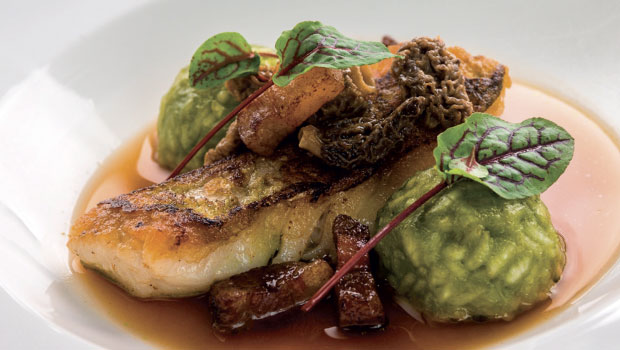From mushrooms and ramps to fiddlehead ferns and dandelion greens, foraged food has become mainstream in many restaurants. Some chefs even forage themselves, like Chef Evan Mallett of Black Trumpet Bistro in Portsmouth, New Hampshire, who calls himself a self-taught forager. He’s been eating wild foods for 20 years and serving them in his restaurant—named after a foraged mushroom—for the last seven. He finds lesser-known varieties such as spruce tips, reindeer lichen (a shrub often used to make aquavit), chaga mushrooms, birch bark, and wintergreen berries from the backyard of his woodsy Maine home.
Mallett says spruce tips, which can be picked directly off the coniferous tree and which produce small, green, tender shoots in the spring, have a strong aroma and taste that make them a great flavor enhancer for stocks, sauces, and cocktails.
With the help of his foraging expert—his 10-year-old son—Mallett cuts reindeer lichen moss from ground surfaces and trees, deep-frying and pulverizing the blue-green, antler-like stems for garnish and flavor infusers.
For a special dinner, he recently made a Wild Things Broth out of chaga mushrooms and birch bark for an unctuous, camphorous, almost root beer-like base to which he added golden tilefish and risotto balls spiked with foraged sorrel. And this month, Mallett is using searocket, a peppery, arugula-like green found on beaches in the Northeast, for a salad with mild miner’s lettuce. He also makes soups and other dishes out of dryad’s saddle, a young and tender, underutilized mushroom with a taste like cool cucumbers.
On the sweeter side of flavors, there’s the papaw (sometimes spelled pawpaw), which is a North American wild fruit and a member of the cherimoya family. It has an extremely short, two-week season, looks like a fat, very ripe banana, and tastes like a cross between a banana, a pineapple, and a mango. Native to Kentucky and surrounding states, it’s often referred to as the tropical fruit of America, the Indiana banana, or the Kentucky banana, and is rarely cultivated because of its short season, which usually occurs at the end of July.
Chef Anthony Lamas of Seviche in Louisville, Kentucky, takes exception to that rule. He collects as much as he can of this wilderness fruit from a nearby farmer who has the wild trees on his property. Tasty in both sweet and savory dishes, Lamas uses the papaw fruit in flan for its creamy, custard-like texture and tropical taste. “It reminds me of the flavors I grew up with,” he says, referencing his Puerto Rican and Mexican heritage.
Because of the short season, Lamas freezes or makes preserves out of the papaw pulp, using it year-round for a habanero pepper-spiked jam spread over warm brie, and in ice cream topped with bourbon dulce de leche and toasted marcona almonds. The pulp also adds sweetness to a beurre blanc sauce served with halibut and couscous. Last year, Chef Lamas preserved 440 pounds of the fruit.
Another foraging collector, Chef Derek Simcik of the Atwood Café in Chicago, simply collects oak tree leaves, which he candies by painting the leaves with a mixture of sugar and boiling water, and then uses for brûlée or other dessert garnishes. He’s also used the colorful, candied leaves as garnish for a fig-stuffed rabbit loin wrapped with bacon and atop a carrot-maple purée.













